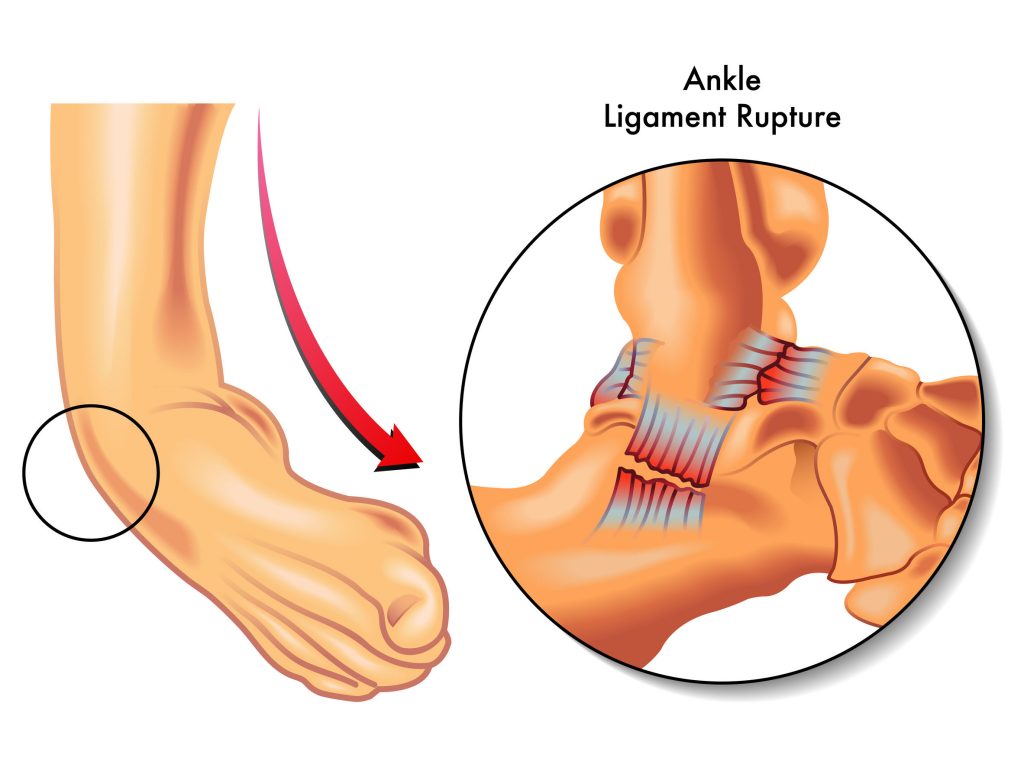Ankle sprain healing time

Ever heard that ankle sprain healing times just take a couple of weeks? Not always.
Ever done a handstand? Actually, most of us can’t, but if you could do one for more than a minute, how do you think your wrists would feel?
The force traveling through your arms to the ground is huge, and your wrists simply couldn’t tolerate it for more than a few minutes.
Which makes our feet and ankles amazing structures.
So, when an ankle injury occurs, it’s not always a simple fix.
How do Ankle Sprains happen?
The most common injury physios see is the ‘rolling in’ sprain which is a classic basketball or netball injury when a player lands on an opponent’s foot.
In this mechanism, the damage occurs to the lateral (outside) ligament complex and results in pain, swelling, bleeding (bruising) and the infamous ‘egg’ on the outside of the ankle.
If the injury is limited to just the lateral ligaments, then recovery is usually 1-2 weeks, and physiotherapy treatment and rehabilitation will make a huge difference.
Ankle Sprain Treatment
Localised treatment, strapping or bracing, exercise, and proprioceptive re-training can facilitate the recovery and often allow an athlete to play, even though they are still in the healing phase.
Sometimes rest is not best. Ankles need rehabilitation, otherwise, you risk having repeated injuries, with lesser stress needed to re-injure them.
Ankles can become a niggling problem and linger for months if not properly addressed.
Ankle Sprain Exercises
Initial Assessment: The first step in the ankle sprain physiotherapy treatment spectrum is an initial assessment. During this assessment, your physiotherapist will examine the injured ankle to determine the extent of the injury and develop a personalized treatment plan. They may also ask you about your symptoms, medical history, and any previous ankle injuries.
Rest and Ice: The next step is to rest the ankle and apply ice to reduce swelling and pain. Your physiotherapist may recommend that you use a compression bandage or a brace to support the ankle and reduce inflammation. They may also suggest that you keep the ankle elevated to help with drainage and to improve blood flow.
Range of Motion Exercises: Once the swelling has gone down, your physiotherapist will prescribe a range of motion exercises to help restore mobility to the ankle. These exercises may include ankle circles, ankle pumps, and ankle stretches. They will likely ask you to perform these exercises several times a day, gradually increasing the intensity and duration as the ankle heals.
Strengthening Exercises: After the range of motion has been restored, your physiotherapist will prescribe strengthening exercises to help rebuild the strength in the ankle. These exercises may include calf raises, heel drops, and resistance band exercises. Your physiotherapist will likely ask you to perform these exercises several times a day, gradually increasing the intensity and duration as the ankle heals.
Functional Exercises: The final step in the ankle sprain physiotherapy treatment spectrum is functional exercises. These exercises are designed to help you return to your normal activities and improve your overall balance and stability. They may include single-leg balance exercises, hopping exercises, and agility drills. Your physiotherapist will work with you to determine which exercises are appropriate for your specific needs and goals.
It's important to note that every patient's ankle sprain recovery journey is unique, and their treatment spectrum may vary depending on the severity of the injury and other individual factors. Your physiotherapist will work closely with you to develop a personalized treatment plan that meets your specific needs and goals.








